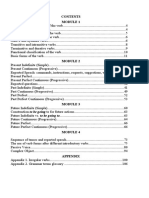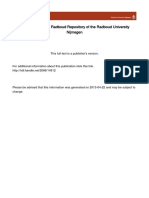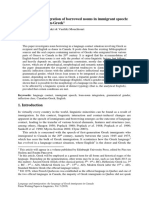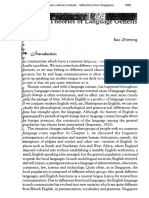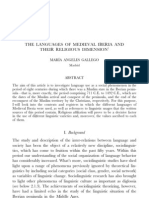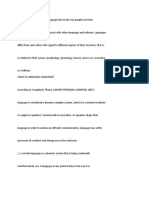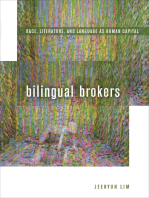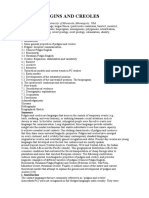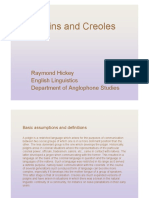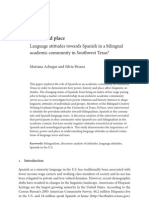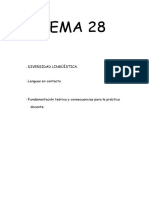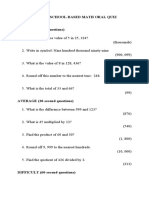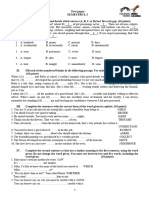JLC Article p213 - 12
JLC Article p213 - 12
Uploaded by
cemkeskinphdCopyright:
Available Formats
JLC Article p213 - 12
JLC Article p213 - 12
Uploaded by
cemkeskinphdOriginal Title
Copyright
Available Formats
Share this document
Did you find this document useful?
Is this content inappropriate?
Copyright:
Available Formats
JLC Article p213 - 12
JLC Article p213 - 12
Uploaded by
cemkeskinphdCopyright:
Available Formats
THE LIMITS OF CONVERGENCE IN LANGUAGE CONTACT
Carmen Silva-Corvalán
University of Southern California
1. Introduction
This article discusses the contact situation between English and Spanish in the USA, a situation
characterized by both maintenance of the minority language and shift to English. Of relevance to
understanding the linguistic phenomena that develop in this situation of societal bilingualism is the
fact that the minority language is constantly being revitalized by interaction with large groups of
immigrants from Spanish-speaking countries.
In this context of societal bilingualism an oral proficiency continuum develops in the two
languages, either as a result of incomplete learning of the minority language or its attrition due to
restricted exposure to and use of this language. The continuum ranges from standard or unrestricted
Spanish to an emblematic use of Spanish and, vice versa, from unrestricted to emblematic English.
At the individual level, the continuum reveals dynamic levels of proficiency in the subordinate
language and different degrees of convergence with English. Speakers can be located at various
points along this continuum, but it is in principle possible for an individual to move or be moving
toward (hence ‘dynamic’ level) one or the other end of the continuum at any given synchronic stage
of his life. This is a fluid situation that may give rise to both borrowing and imposition by the same
agents of transfer at different times throughout their lives (see discussion of these terms in Winford,
2007).
The 2000 Census indicated that the population of the USA was close to three hundred million
(US Bureau of the Census, 2005). Of these, over thirty-five million were Hispanics. About sixty
percent of the Hispanic (or Latino) population resides in the five states referred to as “the
Southwest”: New Mexico, Texas, California, Arizona, and Colorado. It is estimated that by the year
2010 Hispanics will be the nation’s largest minority ethnic group (13.8%) and by 2050 they will
compose twenty-five percent of an estimated total population close to four hundred million (Day,
1996). The Hispanic group would add the largest number of people to the population of the USA
because of higher fertility rates and, importantly for a linguistic perspective, net immigration levels.
The predicted growth in the size of the Hispanic population does not necessarily project a
corresponding percentage growth in the number of speakers of Spanish, however, since once settled
in the USA the shift to English is massive.
Journal of language contact – THEMA 2 (2008)
www. jlc-journal.org
Downloaded from Brill.com 02/27/2024 10:19:20AM
via free access
214 Carmen Silva-Corvalán
Unlike the Northeast, the Hispanic population of the Southwest dates back to the sixteenth
century, when the earliest expeditions of Spaniards from Mexico came to the region. Colonial
Spanish has given way to contemporary varieties of Spanish, however, brought by immigrants who
have come mainly from Mexico. The expanding Hispanic population’s ties with family, friends, and
business associates in Latin America constantly revitalize the Spanish language, and bodes well for
the maintenance of Spanish as a strong societal language in the United States.
The Spanish of US-born Hispanics is characterized by phenomena typical of a situation of
intensive and extensive bilingualism: grammatical and lexical simplification, intensive lexical
borrowing (and imposition) from English, and code-switching, i.e., alternating between Spanish and
English in the same conversational turn or across turns.
It is frequently argued that in the situation described a new language is emerging in the USA,
Spanglish, a mixture of Spanish and English. Examples such as those in (1) and (2), where speakers
smoothly switch between the two languages, are given in support of such proposal:
(1) Un mecánico mexicano le dijo una a la - al que está cocinando en el catering wagon, le
dijo una de doble sentido, una palabra de doble sentido nomás. Nothing serious, nothing
serious, you know, just a- No me acuerdo qué era ni nada. So le hablé yo p’atrás en
español. ‘Ya te agarré la movida’, le dije, ‘Ya te, ya te estoy escuchando’.
‘A Mexican mechanic said one to the- to the one who’s cooking in the catering wagon, he
told him a double sense one, just one double sense word. Nothing serious, nothing serious,
you know, just a- I don’t remember what it was. So I talked back to him in Spanish. “I got
what you said”, I said, “I’m, I’m listening to you”.’
(2) They were laying off. So, I didn’t get laid off. Ramón, Ramón got laid off. And I quit
because he got laid off. Because I was working, and he was working at nights. --- Dije,
‘No, si lo van a descansar a él, ¿pa’ qué me quedo yo, especial yo?’ Yo, de aquí, como,
‘onde puedo agarrar trabajo. El, es más difícil, porque he’s not ‘reglado’ para ‘garrar
trabajo.
‘I said, “No, if they’re going to lay him off, why should I stay, especially me?” I’m from
here, so I can get a job anywhere. As for him, it’s more difficult, because he’s not ‘fixed’
(legalized) to get a job.’
Examples (1) and (2) are from speakers whose grandparents came from Mexico and in whose
homes the main language of communication is English (I refer to them as “group 3” or G3). Note,
however, that even in this situation of reduced exposure to and use of Spanish the segments of
speech in this language preserve its structure and do not replicate that of the dominant language,
English. Indeed, note the retention of typological features foreign to English: the order N-Adj
(mecánico mexicano ‘Mexican mechanic’), the preverbal dative pronoun (le dijo ‘(he) told him’),
null subjects (No me acuerdo ‘(I) don’t remember’), the order VS (le hablé yo ‘I spoke to him’). I
will argue, therefore, that in the process of shifting from Spanish to English at the societal level, and
under the cognitive and social pressure from a dominant language at the individual level, speakers
do not modify the abstract syntactic structure of the receding language; syntax is, it seems, the limit
of convergence.
2. Is syntax “borrowable”?
My goal in this paper is to present arguments and evidence from a number of contact situations
in support of the view that the transfer of features from one language to another does not involve
Journal of language contact – THEMA 2 (2008)
www. jlc-journal.org
Downloaded from Brill.com 02/27/2024 10:19:20AM
via free access
The Limits of Convergence in Language Contact 215
syntax, but lexicon and pragmatics. I will also demonstrate that this type of interlanguage transfer is
constrained by the structure of the recipient language, and by general cognitive principles. Thus,
although it may not be possible to predict that a specific change will occur in a recipient language, it
may be possible to delimit, on the basis of general principles, the nature of the changes and
constraints on their occurrence, given certain specific sociolinguistic conditions.
Making the argument that syntax is not transferred involves the difficulty of having to define
“syntax” since a given phenomenon may be considered to be syntactic by some, but others may
view it as lexical-semantic (e.g., verb subcategorization, selectional restrictions) or morphological
(e.g., clitic pronoun usage, gender agreement). My hypothesis is based on a structuralist definition
of syntax which distinguishes two levels (Gutiérrez Ordóñez 1997): an abstract structural level in
which functions are simply empty slots with no lexical entries, as in (3); and a concrete level with
lexical entries which needs to consider semantic well formedness, as in (4 a & b). Observe that
while (4 a) is semantically appropriate, (4 b) is not because an inanimate entity cannot perform the
action of buying.
Abstract syntactic structure
(3) subject verb direct object
NP V NP
Concrete syntactic structure
(4) a. The hamburger dirtied the plate.
b. *The hamburger bought mayonnaise.
I will show that transfer occurs at the level of concrete syntax, through lexical units or phrases
used in situated acts of communication, and does not affect the basic syntactic typology of the
recipient language. The locus of transfer is the bilingual individual. The diffusion of transfer is a
social phenomenon. Individuals transfer lexical items and pragmatic uses from English (the source
language) and these may eventually lead to syntactic change at the concrete level. Change in the
recipient language (Spanish) occurs when an innovation has spread to a community of speakers, i.e.
at the societal level (cf. Weinreich, Labov & Herzog 1968). Lexical items, subcategorizations,
discourse constraints and pragmatic uses modelled after the source language may gradually
permeate an individual’s grammar and gradually spread across individuals, resulting eventually in
crystallized fixed patterns characteristic of the language used in a community. The innovative
element is part of a linguistic system; therefore, it gradually expands its distribution and generalizes
to other elements. Every innovative pattern at every stage of diffusion, however, is compatible with
the basic typology of the recipient language and enters it through the existence of closely parallel
constructions. Similar hypotheses have been defended by a number of authors (e.g., King 2000;
Landa 1995, 2000; Louden 1997; Prince 1992; Weinreich 1974).
In a situation of extensive and intensive bilingualism, bilinguals are called upon to communicate
often in one language or the other in rapid succession in response to different interlocutors, different
social domains, or other factors. The need to lessen the cognitive effort that this task demands may
explain in part the typical processes of regularization, the loss of infrequently used constructions,
and the conscious or unconscious preferential use of parallel concrete structures in the languages
involved, a phenomenon that leads to convergence. This outcome is widely attested in the literature
(e.g., Campbell 1987; Dorian 1989; Landa 1995; Martineau 1988; Nadkarni 1975; Prince 1992;
Silva-Corvalán 1994). Under conditions of intensive and extensive bilingualism, it seems logical to
expect that frequently used patterns in the socially dominant language will motivate an increase in
the frequency of use of parallel structures in the subordinate language, and that frequently used
patterns within this language will also tend to become extended. This implies a certain degree of
Journal of language contact – THEMA 2 (2008)
www. jlc-journal.org
Downloaded from Brill.com 02/27/2024 10:19:20AM
via free access
216 Carmen Silva-Corvalán
simplification and loss of structures in the subordinate language and a gradual move towards
crosslinguistic convergence.
Cognitive and linguistic considerations, then, may allow us to predict the nature of at least some
of the types of change that may or may not occur, and the constraints on their occurrence. In earlier
work (Silva-Corvalán 1994, 1998), I demonstrated the type of influence that English has had on the
Spanish spoken in Los Angeles (L.A.). There, indirect influence was evident in the preferential use
of parallel structures, and in the gradual loss of discourse-pragmatic constraints not present in
English. But in L.A. Spanish there was no obvious evidence of changes in the typological patterns
of Spanish.
Consider at this point some of the results of this previous research, in particular those concerning
null elements and word order.
3. Spanish in contact with English
3.1. Expressed and null subjects, and placement of expressed subjects
In earlier work (Silva-Corvalán 1994) I examined the possibility that Spanish might develop
rules of obligatory subject expression and categorical preverbal placement of subjects. Qualitative
and quantitative analyses, however, indicated a trend toward fewer expressed subjects among
bilinguals born in the USA (Groups 2 and 3),1 which I interpret as a sign of gradual loss of
pragmatic functions associated with the expression of subjects. I also ascertained that
English-dominant bilinguals show higher percentages of preverbal subjects with unaccusative verbs
(ex. 5 a), which usually introduce new entities into discourse and are expected to be placed
postverbally in Spanish not in contact with English (General Spanish).
(5) a. Estaban peleando y entonces la policía llegó. (Group 2)
‘They were fighting and then the police came.’
b. Estaban peleando y entonces llegó la policía. (General Spanish)
English is a strict SVO language that requires the expression of a grammatical subject. Thus, the
fact that L.A. Spanish evidences a lower frequency of subject expression and a higher frequency of
preverbal subjects (SV order) is incompatible with a hypothesis of direct syntactic influence from
English, even if syntax were to be defined as form plus meaning or discourse function. More
adequate explanations are found instead by positing the loss of discourse-pragmatic constraints.
Indeed, group 2 and 3 speakers may be less sensitive to the pragmatic rule that motivates the
placement of new information subjects in postverbal position in Spanish (as in 5 b). Likewise, they
may generalize the option of a non-expressed subject to discourse contexts which would favor it,
e.g., when the referent is being established as the topic of a discourse passage.
3.2. Null complementizer/relative pronoun que ‘that’
English has the possibility of a zero complementizer in relative and complement clauses, as in (6
a), while Spanish disallows them in the parallel structure (6 b).
(6) a. She told me (0) she was delighted with the vase (0) she had just bought.
b. (Ella) me dijo *(que) (ella) estaba feliz con el jarrón *(que) (ella) había comprado.
1
I differentiated three groups of speakers. Briefly, Group 1, immigrants from Mexico after age 11 (Spanish
dominant); Group 2, speakers born in the USA whose parents had come from Mexico (English dominant);
Group 3, speakers born in the USA whose grandparents had come from Mexico (English dominant).
Journal of language contact – THEMA 2 (2008)
www. jlc-journal.org
Downloaded from Brill.com 02/27/2024 10:19:20AM
via free access
The Limits of Convergence in Language Contact 217
English-dominant bilinguals in L.A. produce Spanish sentences with a null complementizer in
complement clauses (7 a) but not in relative clauses (7 b).
(7) a. Yo creo 0 inventaron el nombre que le pusieron. (Group 2)
‘I believe 0 they invented the name that they gave her.’
Importantly, omission of que ‘that’ in complements is allowed in formal or written registers of
General Spanish (Subirats-Rüggeberg 1987), but not in relative clauses. In addition, null que is
attested in the informal oral mode of some varieties of Eastern Mexican Spanish, which may
explain its occurrence in group 1 immigrants. Its extension to or retention in conversational Spanish
may have been favored in Mexico by the fact that some indigenous languages do not require a free
subordinator in complement clauses (Hekking & Muysken 1995), and in L.A. by contact with
English. But the structure of Spanish constrains this transfer to occur only in complement clauses of
request and estimative verbs like creer ‘to believe’, pensar ‘to think’, and saber ‘to know’.
English may have had a similar indirect influence on que deletion in Canadian French, where
deletion is attested fairly frequently in complement clauses of such verbs as penser ‘to think’, dire
‘to say’, savoir ‘to know’, croire ‘to believe’ (Martineau 1993) (ex. 8), but it also occurs, with
lower frequencies, in circumstantial and relative clauses, as shown in examples (9) and (10), taken
from Martineau (1988).
(8) Je pense que / 0 c’est ça.
‘I think that / 0 it’s that’.
(9) C’est ça que / 0 je dis.
‘That’s what I say’.
(10) C’est parce que / 0 tu veux.
‘It’s because you want to’.
Complementizer deletion in Canadian French most probably results from the retention and
gradual generalization of a construction which is reported as frequent in historical grammars until
the period of Classical French (Foulet 1977:333). Note, furthermore, that deletion has also been
retained in modern varieties of popular French in France (Martineau 1993:81).
In L.A. Spanish and in Canadian French, then, deletion of que has firm roots in the parent
non-English contact dialects. The restriction in L.A. Spanish to a type of complement clause where
other Spanish registers also allow zero que argues in favor of constraints on syntactic change due to
contact: in its early stages, change is evident in the more frequent use of a parallel structure. This, in
time, may open the door to further changes and restructuring which would be constrained by the
structure of the language itself.
3.3. Lexico-syntactic calques
Further doors to change are opened by what I call “lexico-syntactic calques”. In these cases, an
English word or an English “expression” (in the technical sense of the word, cf. Tomasello,
2003:100) is matched up with a Spanish word or expression. The word in the receiving language
may incorporate semantic components, as well as subcategorization and selectional restrictions
from English, but it must originally share some semantic or pragmatic component with the
corresponding element in the contact language.
Transfer starts with the calquing of concrete structures in situated acts of communication, but in
time the lexical units affected may change their semantic features and their possibilities of co-
occurrence beyond the specific construction which was originally transferred. Indeed, if novel ways
Journal of language contact – THEMA 2 (2008)
www. jlc-journal.org
Downloaded from Brill.com 02/27/2024 10:19:20AM
via free access
218 Carmen Silva-Corvalán
of putting words together, usually constituting semantic extensions, come into a language through
transfer, they may eventually become fixed in (concrete) syntax (cf. García 1995:53), in the sense
that they become mechanical and habitual in a speech community (Otheguy 1995).
Consider examples (11) and (12) from Los Angeles Spanish. In Spanish, the interrogative adverb
of manner cómo does not have the meaning of ‘to what extent, amount, or degree’ as how may have
in English. As indicated in the General Spanish (Gen.Span.) versions, questions which ask about the
extent to which something is or was liked, as in ex. (11), should not include the interrogative word
cómo, since cómo-questions must be answered with a description of the manner in which the
situation obtains, as in (12). Yet ex. (11 a) and the answer in (11 b) are attested in L.A. Spanish.
(11) a.: Y tu carro que compraste, ¿cómo te gusta? (Group 2)
lit.: and your car that (you) bought, how to-you pleases?
Gen. Span.: Y el carro que compraste, ¿te gusta?
lit.: and the car that (you) bought, to-you pleases?
‘And the car you bought, how do you like it?.’
b.: Mi carro me encanta. (Group 2)
‘I love my car.’
*Me gusta amplio.
*’I like it spacious.’
(12) Gen. Span.: a. ¿Cómo te gusta el café?
‘How do you like coffee?’
b. Me gusta cargado.
‘I like it strong.’
Example (12) shows that the concrete syntactic structure cómo X gustar Y exists in Spanish and
has not been transferred from the parallel English construction. What has been transferred from
English is the possibility of using the construction to ask about the extent to which something or
someone is liked. This new usage may affect the meaning of the question adverb cómo, which did
not have the component “to what extent” but may now be used with this sense. Note, however, that
the inference of “to a great extent” was possible in a type of rather infrequent exclamation in
Spanish, illustrated in ex. 13,2 which could be inferred to communicate that the speaker likes
something a great deal. Thus, examples of the type of (11) constitute a new pragmatic use, a new
expression, and not an innovation at the abstract level of syntactic structure.
(13) ¡Cómo me gustan los churros con chocolate!
‘How I like churros with chocolate!’
The distribution of how is transferred as well to a declarative context, namely to the complement
of saber ‘to know’. Here again, Spanish cómo in the complement of saber ‘to know’ refers to the
manner of a specific situation, as in ex. (14 a), which could be appropriately followed up by
instructions on ‘how to’, as in (14 b). Note, however, that the wider meaning of how in English
allows it to occur with to know when only a general knowledge or skill required to do something is
being referred to, as in ex. (15). While in General Spanish ex. (15) must be translated without cómo
‘how’, this complementizer is acceptable in L.A. Spanish, as shown by ex. (16).
(14) a. María no sabe cómo irse a la universidad.
‘Mary doesn’t know how to go to the university.’
2
I thank Ricardo Otheguy for bringing this fact to my attention.
Journal of language contact – THEMA 2 (2008)
www. jlc-journal.org
Downloaded from Brill.com 02/27/2024 10:19:20AM
via free access
The Limits of Convergence in Language Contact 219
b. Dile que tome el bus 73.
‘Tell her to take bus 73.’
(15) He doesn’t know how to read yet.
‘No sabe 0 leer todavía.’
(16) Sí sabía como hablar español. (Group 3)
lit.: yes knew-3sg how speak-inf Spanish
Gen. Span.: Sí sabía 0 hablar español.
‘He did know how to speak Spanish.’
The examples in (11) and (16) represent new cooccurrence patterns or concrete syntactic
patterns. Similar cases affect other words and expressions in Spanish, e.g., the word tiempo ‘time’,
as in (17) and (18), the demonstrative este ‘this’ in the introduction of a new entity in discourse, as
in (19) (new-this in English, Wald, 1983).
(17) Es un modo de tener un buen tiempo.3 (Group 3)
lit.: (it)’s a way to have a good time
Gen. Span.: Es un modo de pasar un buen rato / pasarlo bien
lit.: (it)’s a way to pass a good moment / pass it well
‘It’s a way to have a good time.’
(18) ... pero cuando llegó el tiempo que ellos ya querían sus carritos... (Group 3)
lit.: but when arrived the time that they already wanted their cars
Gen. Span.: pero cuando llegó el momento que ellos ya querían sus carritos…
lit.: but when arrived the moment that they already wanted their cars
‘… but when the time came when they wanted their car …’
(19) Estábamos en el patio cuando este niñoi se me acercó y me empezó a molestar, así que yo loi
empujé y ...’ (Group 2)
‘We were in the school yard when this boyi came up to me and started bugging me, so I pushed
himi and ...’
Gen. Span.: Estábamos en el patio cuando un niñoi se me acercó y me empezó a molestar, así que
yo loi empujé y ...’
The word tiempo is quite vulnerable in a Spanish-English contact situation because many but not
all the uses of English ‘time’ overlap with it. This situation most likely favors the extension of
tiempo, basically a durative mass concept in Spanish, to incorporate the notion of one specific point:
‘one of several instances, an occasion, an hour, a moment’ (ex. 18). In Spanish, the phrase buen/mal
tiempo (as in ex. 17), in the singular, can only mean ‘good/bad weather’.
In all the cases discussed, the word or expression that comes to be used in an innovative way in
Spanish shares some component with the corresponding English word or expression, and no change
has affected the abstract syntax of Spanish.
To summarize, then, L.A. Spanish evidences an increased frequency of structures that have
parallels in English. This increase involves:
3
Note that the abstract structure exists [Prep V DO], and it may be lexically filled as in such parallel example
as Es el deseo de tener un buen salario ‘It’s the desire to have a good salary.’
Journal of language contact – THEMA 2 (2008)
www. jlc-journal.org
Downloaded from Brill.com 02/27/2024 10:19:20AM
via free access
220 Carmen Silva-Corvalán
a) gradual loss of discourse-pragmatic constraints (e.g., affecting word order, and the expression
of subjects);
b) gradual loss of register constraints (e.g., complementizer deletion);
c) gradual alteration of selectional restrictions (e.g., affecting como ‘how’, tiempo ‘time’).
4. Beyond Los Angeles
Consider now some cases of contact between Spanish and languages other than English which
are typologically more distant from Spanish.
The old contact situation involving Spanish and Basque, for instance, offers supporting evidence
for our general thesis that syntax is the limit of convergence. Despite the intense cultural and
linguistic pressures of more than seven hundred years, Basque has remained typologically very
different from Spanish: it continues to be an ergative language with OV basic word order. Landa &
Elordui (1999:230) have shown that there has been some interlanguage influence, but this has
involved lexical phenomena and the loss of semantic or pragmatic restrictions which have resulted
in structures innovative only at the concrete level.
Spanish has had over four centuries of contact with indigenous American languages which have
borrowed even so-called “unborrowable” function words (Brody, 1995). But Brody and Hekking &
Muysken (1995) examine a number of these indigenous languages from Mexico to Ecuador and
independently argue that these languages have borrowed conjunctions with primarily discourse
meanings.4 In some cases the borrowings ended up replacing some of the native particles, but at
first the conjunctions “nearly always occur along with an indigenous element that fulfills a similar
function” (Brody 1995:140).
Hekking & Muysken (1995) further observe that Otomi, for instance, borrows many more
prepositions and conjunctions than Quechua does from Spanish, and surmise that this difference is
most likely due to their dissimilar typologies. Otomi, like Spanish, is a right-branching language
(VO) while Quechua is left-branching (OV). In Quechua, they affirm that only que ‘that’ appears to
have “a clearly defined grammatical role” (p. 112), while the rest of the borrowings seem to
function as “discourse markers”. Note, however, that que occurs redundantly with the indigenous
subordinator -spa, making que repetitive and grammatically unclear. Consider their example (4),
reproduced here as (20):
(20) chanta atoj-taj-ri willasku-spa que pega-mu-sqa
thus fox_ENF_RF say_SUB that hit-CIS-NAR
‘Así el zorro diciendo que iba a pegar ...’
‘Thus the fox saying that he was going to hit ...’
[ENF= emphatic; RF= referential; SUB= adverbial subordinator; CIS= “cislocative”? (“like
here”); NAR= narrative tense]
The Quechua construction marks ‘to say’ with the suffixed Quechua subordinator -spa; que is
redundant and precedes a clause that maintains Quechua structure in all other respects. Given a
situation of this sort, one may predict, based on the principles of regularity and transparency, that
the subordinate language will tend to substitute the free, invariant, and unambiguous marker for the
bound and multifunctional Quechua form.
4
The conjunctions borrowed include y luego ‘and then’, como ‘like’, pues ‘because, well...’, porque
‘because’, pero ‘but’, que ‘that’, si ‘if’ and sino que ‘but’ in various languages.
Journal of language contact – THEMA 2 (2008)
www. jlc-journal.org
Downloaded from Brill.com 02/27/2024 10:19:20AM
via free access
The Limits of Convergence in Language Contact 221
Justifiably, then, one may conclude that these so-called “grammatical borrowings” are indeed
lexical: conjunctions, subordinators, and prepositions that did not affect the syntax of the recipient
language when they were transferred. Note the concurrence between Brody’s and Hekking &
Muysken’s data: in all these situations the subordinating conjunctions borrowed occur redundantly
with the indigenous element. Furthermore, Hekking & Muysken add that the structural differences
between Otomi and Quechua appear to explain more appropriately than historical, demographic,
and social factors the different ways in which these languages adopt and adapt function-word loans.
5. Final remarks
The studies discussed strongly support my proposal that transfer is constrained by the structure
of the languages involved, and contradicts the claim that “anything goes” (Campbell & Muntzel,
1989; Thomason & Kaufman 1988), at least under some sociolinguistic conditions. There is
evidence for lexical transfer, some of which may have syntactic consequences. There is also gradual
loss of discourse-pragmatic restrictions as well as incorporation of new uses of existing structures,
all of which produce a slight foreign quality, comparable to what happens at the phonetic level.
Many of the studies that have argued for “grammatical borrowing” in contact situations (e.g.,
Campbell, 1993; Nadkarni, 1975; Gumperz & Wilson, 1971; Thomason, 1986) have focused mainly
on the outcome of centuries-long language contact and lack the critical data to examine the early
stages of change. Be that as it may, most of the changes presented correspond to reductions or
generalizations, rather than to the incorporation of foreign structures. Let me reassert, however, that
mine is not an argument against the existence of externally caused changes. On the contrary, it is
impossible to deny the impact that intensive language contact may have, especially on a subordinate
language. What I have attempted to show is that every change allowed appears to be constrained by
the structure of the affected language.
The effect of this linguistic filter, as it were, may have been what motivated Thomason’s
statement that “the innovated structure and the source-language structure need NOT be
identical...non-identical interference features are common” (1986:245). We may ask ourselves why
“non-identical interference features are common”. The answer, it seems to me, lies precisely in the
fact that what is transferred is NOT a syntactic structure, but the semantics or the pragmatics of a
construction, which is then linked to a closely structural parallel in the recipient language. I would
like to make the stronger claim that the paired structures need to share at least one element of
meaning or one pragmatic function (cf. Prince, 1992), as illustrated in ex. (21).
(21) Se fue pa’ atrás pa’ México. (Concrete structure B)
‘He went back to Mexico.’ (Concrete structure A)
Gen. Span.: Regresó a México.
‘He returned to Mexico.’
In example (21), the bilingual speaker has established a parallel between (go) back and (ir) para
[pa’] atrás, superficially parallel since the structures are not identical: [V Adv] in English, but [V
Prep Adv] in Spanish. A and B have corresponding lexical elements with partially equivalent
meaning: go = ir in Voy a México ‘I go to Mexico’, and back = atrás in Está atrás ‘It’s in the back’,
but back and atrás do not share the metaphorical extension that includes the concept of repetition or
return in English (as in go back, call back, give back, etc.). This meaning is copied onto para atrás,
which in General Spanish only has the literal location meaning (pasar (X) para atrás ‘pass (X) to
the back’).
Journal of language contact – THEMA 2 (2008)
www. jlc-journal.org
Downloaded from Brill.com 02/27/2024 10:19:20AM
via free access
222 Carmen Silva-Corvalán
This type of contact-induced change may be schematized as in Figure 1.
________________________________________________________________________
Language F (dominant) Language S (secondary)
concrete structure A: concrete structure B:
meaning or pragmatic uses (x, z) meaning or pragmatic uses (x, y)
where A superficially parallels B
then:
A (x, z) is copied on B > (x, (y), z)
________________________________________________________________________
Figure 1. Possible interlinguistic influence across parallel structures.
References
Brody, Jill. 1995. Lending the “unborrowable”: Spanish discourse markers in indigenous American
languages. In Carmen Silva-Corvalán, Spanish in four continents: Studies in bilingualism
and language contact, 132-147. Washington, D.C.: Georgetown University Press.
Campbell, Lyle. 1987. Syntactic change in Pipil. International Journal of American Linguistics
53:253-280.
Campbell, Lyle. 1993. On proposed universals of grammatical borrowing. In Henk Aertsen &
Robert Jeffers, Historical Linguistics 1989, 91-109. Amsterdam: John Benjamins.
Campbell, Lyle & Martha C. Muntzel. 1989. The structural consequences of language death. In
Nancy C. Dorian, Investigating obsolescence, 181-196. Cambridge: Cambridge University
Press.
Day, Jennifer C. 1996. Population projections of the United States by age, sex, race, and Hispanic
origin: 1995 to 2050. US Bureau of the Census, Current Population Reports, P25-1130.
Washington, D.C.: US Government Printing Office.
Dorian, Nancy, ed. 1989. Investigating obsolescence. Cambridge: Cambridge University Press.
Foulet, Lucien. 1977. Petite syntaxe de l’Ancien Français. 13th edition. Paris: Librairie Honoré
Champion.
García, Erica. 1995. Frecuencia (relativa) de uso como síntoma de estrategias etnopragmáticas. In
Klaus Zimmermann, Lenguas en contacto en Hispanoamérica, 51-72. Frankfurt: Vervuert.
Gumperz, John & Robert Wilson. 1971. Convergence and creolization. In Dell Hymes,
Pidginization and creolization of languages, 151-167. Cambridge: Cambridge University
Press.
Gutiérrez Ordóñez, Salvador. 1997. Temas, remas, focos, tópicos y comentarios. Madrid:
Arco/Libros.
Journal of language contact – THEMA 2 (2008)
www. jlc-journal.org
Downloaded from Brill.com 02/27/2024 10:19:20AM
via free access
The Limits of Convergence in Language Contact 223
Hekking, Ewald & Pieter Muysken. 1995. Otomí y Quechua: una comparación de los elementos
gramaticales prestados del español. In Klaus Zimmermann, Lenguas en contacto en
Hispanoamérica, 101-118. Frankfurt: Vervuert.
King, Ruth. 2000. The lexical basis of grammatical borrowing: A Prince Edward Island case study.
Amsterdam: John Benjamins.
Landa, Alazne. 1995. Conditions on null objects in Basque Spanish and their relation to leísmo and
clitic doubling. Ph.D. dissertation, University of Southern California.
Landa, Alazne. 2000. Del paralelismo estructural a la convergencia gramatical: contacto español-
vasco. In Annick Englebert, Michel Pierrard, Laurence Rosier & Dan Van Raemdonck,
Actes du XXIIe Congrès de Linguistique et de Philologie Romanes, vol. VI, 285-292.
Tübingen/Max Niemeyer Verlag.
Landa, Alazne & Agurtzane Elordui.1999. Gramáticas en contacto: Condiciones de permeabilidad y
tendencias universales. In Angel Yanguas & Francisco J. Salguero, Estudios de lingüística
descriptiva y comparada, 229-238. Sevilla: Kronos.
Louden, Mark L. 1997. Linguistic structure and sociolinguistic identity in Pennsylvania German
society. In James R. Dow & Michèle Wolff, Languages and lives: Essays in honor of
Werner Enninger, 79-91. New York: Peter Lang.
Martineau, Frances. 1988. Variable deletion of que in the spoken French of Ottawa-Hull. In J.P.
Montreuil & D. Birdsong, Advances in Romance Linguistics, 275-287. Dordrecht: Foris.
Martineau, Frances. 1993. Rection forte et rection faible des verbes: l’ellipse de que en français du
Québec et de l’Ontario. Francophonies d’Amérique 3:79-90.
Nadkarni, Mangesh V. 1975. Bilingualism and syntactic change in Konkani. Language 51:672-83.
Otheguy, Ricardo. 1995. When contact speakers talk, linguistic theory listens. In E. Contini-
Morava, & B. Sussman, Meaning as explanation: Advances in linguistic sign theory, 213-
242. Berlin: Mouton de Gruyter.
Prince, Ellen. 1992. On syntax in discourse, in language contact situations. In Claire Kramsch & S.
McConnell-Ginet, Text and context: Cross-disciplinary perspectives on language study, 98-
112. Boston: D.C. Heath.
Silva-Corvalán, Carmen. 1994. Language contact and change: Spanish in Los Angeles. Oxford:
Clarendon.
Silva-Corvalán, Carmen. 1998. On borrowing as a mechanism of syntactic change. In A. Schwegler
et al., Romance linguistics: Theoretical perspectives, 225-246. Amsterdam: John
Benjamins.
Subirats-Rüggeberg, Carlos. 1987. Sentential complementation in Spanish. Amsterdam: John
Benjamins.
Thomason, Sarah G. 1986. On establishing external causes of language change. In Soonja Choi et
al., Proceedings of the Second Eastern States Conference on Linguistics, 243-251.
Columbus: Department of Linguistics, Ohio State University.
Journal of language contact – THEMA 2 (2008)
www. jlc-journal.org
Downloaded from Brill.com 02/27/2024 10:19:20AM
via free access
224 Carmen Silva-Corvalán
Thomason, Sarah, & Terence Kaufman. 1988. Language contact, creolization, and genetic
linguistics. Berkeley: University of California Press.
Tomasello, Michael. 2003. Constructing a language. A usage-based theory of language acquisition.
Cambridge: Harvard University Press.
US Bureau of the Census. 2005. Population Division. Washington, D.C.: US Government.
Wald, Benji. 1983. Referents and topic within and across discourse units: Observations from current
vernacular English. In Flora Klein-Andreu, Discourse perspectives on syntax, 91-116. New
York: Academic Press.
Weinreich, Uriel. [1953] 1974. Languages in contact, eighth printing. The Hague: Mouton.
Weinreich, Uriel, William Labov & M. Herzog. 1968. Empirical foundations for a theory of
language change. Winifred Lehmann & Yakov Malkiel, Directions for historical
linguistics, 95-195. Austin: University of Texas Press.
Winford, Donald. 2007. Some issues in the study of language contact. Journal of Language
Contact, Thema 1:22-39. www.jlc-journal.org.
Journal of language contact – THEMA 2 (2008)
www. jlc-journal.org
Downloaded from Brill.com 02/27/2024 10:19:20AM
via free access
You might also like
- APA 7th Edition PDFDocument25 pagesAPA 7th Edition PDFTalent Tonderai Zuze100% (10)
- 7th NewDocument12 pages7th NewNada HojeratNo ratings yet
- All TensesDocument108 pagesAll TensesПоліна Олександрівна МасловськаNo ratings yet
- Haugen Analysis Linguistic BorrowingDocument23 pagesHaugen Analysis Linguistic BorrowingInpwNo ratings yet
- Lesson Plan 1: Discussion On The Final Chapter (Synchronous)Document15 pagesLesson Plan 1: Discussion On The Final Chapter (Synchronous)api-530707431No ratings yet
- Otheguy 2016 G2 PDFDocument20 pagesOtheguy 2016 G2 PDFMargaretNo ratings yet
- VillamillsDocument22 pagesVillamillsFabián DíazNo ratings yet
- munozperezEtAl 22 America.2Document31 pagesmunozperezEtAl 22 America.2joseNo ratings yet
- Variación Y Cambio Lingüístico en Lengua Inglesa: Grado en Estudios InglesesDocument17 pagesVariación Y Cambio Lingüístico en Lengua Inglesa: Grado en Estudios InglesesGustavo CampanalesNo ratings yet
- Philippine EnglishDocument16 pagesPhilippine EnglishMa'am Rics BulutanoNo ratings yet
- Linguistics, Comparative AnalysisDocument19 pagesLinguistics, Comparative AnalysiszarizkullenNo ratings yet
- Ethnicity and CultureDocument4 pagesEthnicity and Culturedafher1No ratings yet
- False Friends: A Historical Perspective and Present Implications For Lexical Acquisition 1Document14 pagesFalse Friends: A Historical Perspective and Present Implications For Lexical Acquisition 1Alexander DimitrichenkoNo ratings yet
- Chicano EngDocument15 pagesChicano EngCintia GallegoNo ratings yet
- One Speaker Two Languages Cross Discipli (2) Milroy and MyskenDocument16 pagesOne Speaker Two Languages Cross Discipli (2) Milroy and MyskenKKNT Belaras2019No ratings yet
- Morphological BorrowingDocument14 pagesMorphological BorrowingIrfan Andi SuhadaNo ratings yet
- 3069 5320 1 SMDocument23 pages3069 5320 1 SMSimos TsolakidisNo ratings yet
- Presentation 09 Language ChangeDocument68 pagesPresentation 09 Language ChangeagelatphotosNo ratings yet
- Language Contact - Misunderstanding, Confusion and ConflictsDocument9 pagesLanguage Contact - Misunderstanding, Confusion and Conflictsعمرو قجيدعNo ratings yet
- Paper 1136Document16 pagesPaper 1136Martin LsNo ratings yet
- Language GenesisDocument32 pagesLanguage Genesisquynhmai200197No ratings yet
- Is "Spanglish" The Third Language of The South? - Truth and Fantasy About U.S. Spanish - LipskiDocument27 pagesIs "Spanglish" The Third Language of The South? - Truth and Fantasy About U.S. Spanish - Lipskiandré_kunzNo ratings yet
- A Corpus of American and British English: A Case Study of SlangDocument18 pagesA Corpus of American and British English: A Case Study of SlangStefania TarauNo ratings yet
- 55 Spanglish FinalDocument9 pages55 Spanglish Finalarielle mafoNo ratings yet
- Gallego (M. A.) - The Languages of Medieval Iberia and Their Religious Dimension PDFDocument34 pagesGallego (M. A.) - The Languages of Medieval Iberia and Their Religious Dimension PDFJean-Pierre MolénatNo ratings yet
- Expatiate The Assertion That "A Language Is A Dialect With An Army and A Navy".Document6 pagesExpatiate The Assertion That "A Language Is A Dialect With An Army and A Navy".MARYAM DAMILOLA ABDULKAREEMNo ratings yet
- Variación Y Cambio Lingüístico en Lengua Inglesa: Grado en Estudios InglesesDocument20 pagesVariación Y Cambio Lingüístico en Lengua Inglesa: Grado en Estudios InglesesGustavo CampanalesNo ratings yet
- Linguistic VariationDocument9 pagesLinguistic VariationIsel EspirituNo ratings yet
- Language Policy in BoliviaDocument11 pagesLanguage Policy in Bolivia陈妍妍No ratings yet
- Callesano Carter 2019Document15 pagesCallesano Carter 2019Tzintia MontañoNo ratings yet
- 2002 - Bidirectional Transfer PDFDocument25 pages2002 - Bidirectional Transfer PDFSary MamNo ratings yet
- Sign Language Contact and InterferenceDocument29 pagesSign Language Contact and InterferenceAdam Damanhuri100% (1)
- Bilingual Brokers: Race, Literature, and Language as Human CapitalFrom EverandBilingual Brokers: Race, Literature, and Language as Human CapitalNo ratings yet
- Lipski Is Spanglish The Third Language of The SouthDocument6 pagesLipski Is Spanglish The Third Language of The SouthYomeritodetoluca50% (2)
- SosialinguistikDocument14 pagesSosialinguistikfaujonasrulNo ratings yet
- History of Loan Words in English SourcesDocument6 pagesHistory of Loan Words in English SourcesGlennette AlmoraNo ratings yet
- Practical Work Nº2 MarcoDocument4 pagesPractical Work Nº2 MarcoVir UmlandtNo ratings yet
- Felix_Rodriguez_Spanish_contribution-outputDocument8 pagesFelix_Rodriguez_Spanish_contribution-outputMedeaNo ratings yet
- Glocalisation and The Ausbau Sociolinguistics of Modern Europe - Trudgill 2004Document18 pagesGlocalisation and The Ausbau Sociolinguistics of Modern Europe - Trudgill 2004krenari68No ratings yet
- Lexical VariationDocument20 pagesLexical Variationmonica rahma putriNo ratings yet
- Pidgins and CreolesDocument4 pagesPidgins and CreoleskimroberNo ratings yet
- Creole Lang. TeachingDocument3 pagesCreole Lang. TeachingOrwin HermansteinNo ratings yet
- SummaryDocument18 pagesSummaryNico CevallosNo ratings yet
- Pidgins and CreolesDocument6 pagesPidgins and CreolesAzizaNo ratings yet
- Kerswill - Language Contact and Language ChangeDocument197 pagesKerswill - Language Contact and Language ChangeMNNo ratings yet
- Language VariationDocument5 pagesLanguage VariationTanveer AkramNo ratings yet
- LinguisticsDocument5 pagesLinguisticsOumniaNo ratings yet
- Code switchingDocument8 pagesCode switchingrahulabu3No ratings yet
- Notes On Linguistic VarietiesDocument18 pagesNotes On Linguistic Varietiesahmadkamil94No ratings yet
- Lecture11bHandout LgContactDocument3 pagesLecture11bHandout LgContactJenniferNo ratings yet
- Rapa Nui Ways of Speaking Spanish Language Shift and Socialization On Easter Island PDFDocument36 pagesRapa Nui Ways of Speaking Spanish Language Shift and Socialization On Easter Island PDFMarisol García RodríguezNo ratings yet
- Homework Week 2 SociolinDocument3 pagesHomework Week 2 SociolinSummer BreezeNo ratings yet
- Pidgins and Creoles: Raymond Hickey English Linguistics Department of Anglophone StudiesDocument47 pagesPidgins and Creoles: Raymond Hickey English Linguistics Department of Anglophone StudiesSanila TariqNo ratings yet
- Calvet PaperDocument27 pagesCalvet PaperrazielkaNo ratings yet
- Unit 4Document47 pagesUnit 4Lalitha RajaNo ratings yet
- Socio LinguisticsDocument20 pagesSocio LinguisticshamadaNo ratings yet
- A - 018 - Ni Kadek Budiani - Summary Week 4Document3 pagesA - 018 - Ni Kadek Budiani - Summary Week 4Komang DeviyantiNo ratings yet
- Power and Place (Language Attitudes Spanish)Document26 pagesPower and Place (Language Attitudes Spanish)RuiseñorNo ratings yet
- Dame Un Hamburger Plain Con Ketchup y Papitas, Cortés Et AlDocument8 pagesDame Un Hamburger Plain Con Ketchup y Papitas, Cortés Et Alandre KunzNo ratings yet
- The Loss of The 'Voseo' in Chilean Spanish: Evidence in LiteratureDocument16 pagesThe Loss of The 'Voseo' in Chilean Spanish: Evidence in LiteraturevcautinNo ratings yet
- Language Change and Language ContactDocument18 pagesLanguage Change and Language ContactBruz QuillcaNo ratings yet
- Tema 28Document13 pagesTema 28Rocío Fernández RiberaNo ratings yet
- 1-Definition (A Really Full Good Definition) 2-History 3-Types or Classes 4-ExamplesDocument8 pages1-Definition (A Really Full Good Definition) 2-History 3-Types or Classes 4-ExamplesVir UmlandtNo ratings yet
- An American Language: The History of Spanish in the United StatesFrom EverandAn American Language: The History of Spanish in the United StatesNo ratings yet
- APznzaa7HM8V7JBZFrYESFw4gNTnh9BKcPbGPshpSsaLEFCiSKOuMAmQVZsDI65VU27ue3VxeRS-_yMJTuNVCsdGGXtZ-X3l119nTPpmI3D1E0WL47vNMveS_gaR1qgNLAMM0etd_G2bCtWsaM1fb76rZBFmsBqxyOV2VpPlgK2v3PIohIWz71-Zdqvi2VRAjJmIpWqz0wJjpPyEpXDocument7 pagesAPznzaa7HM8V7JBZFrYESFw4gNTnh9BKcPbGPshpSsaLEFCiSKOuMAmQVZsDI65VU27ue3VxeRS-_yMJTuNVCsdGGXtZ-X3l119nTPpmI3D1E0WL47vNMveS_gaR1qgNLAMM0etd_G2bCtWsaM1fb76rZBFmsBqxyOV2VpPlgK2v3PIohIWz71-Zdqvi2VRAjJmIpWqz0wJjpPyEpXnaticastagninoNo ratings yet
- Class 11 EnglishDocument24 pagesClass 11 Englishgoundjitu288No ratings yet
- Announcement SoalDocument8 pagesAnnouncement SoalirmansyahNo ratings yet
- Dissertaion Finale VersionDocument100 pagesDissertaion Finale VersionNoureddine MoussaouiNo ratings yet
- ssc.digialm.com__per_g27_pub_32874_touchstone_AssessmentQPHTMLMode1__32874O2465_32874O2465S6D19752_1733990968713350_2201058271_32874O2465S6D19752E1.htmlDocument76 pagesssc.digialm.com__per_g27_pub_32874_touchstone_AssessmentQPHTMLMode1__32874O2465_32874O2465S6D19752_1733990968713350_2201058271_32874O2465S6D19752E1.htmldhayal1221No ratings yet
- Grade 4 Math Quiz OralsDocument3 pagesGrade 4 Math Quiz OralsJonal AdvinculaNo ratings yet
- Soal Kasus RefleksiDocument9 pagesSoal Kasus RefleksiSahrudin DoankytyyyNo ratings yet
- Olen 2015 Locala SB IxDocument2 pagesOlen 2015 Locala SB IxAdriana BrebenelNo ratings yet
- 1st Year QuizDocument2 pages1st Year QuizNour El Islem LabidiNo ratings yet
- Dangling ModifiersDocument25 pagesDangling Modifiersكريم نبيل عبدالرحيم محمد محمدNo ratings yet
- Caption Writing 2020Document3 pagesCaption Writing 2020Aple RigorNo ratings yet
- Translation Problems and SolutionsDocument8 pagesTranslation Problems and SolutionsPatatas Sayote100% (2)
- Lesson Plan For TP 4Document8 pagesLesson Plan For TP 4Varsha Kashyap100% (1)
- Reported Speech 4Document4 pagesReported Speech 4Nguyễn Trúc Thanh HằngNo ratings yet
- The Role of English in Intercultural CommunicationDocument11 pagesThe Role of English in Intercultural CommunicationRizqa MahdynaNo ratings yet
- Past Continuous and Past SimpleDocument2 pagesPast Continuous and Past SimplebayaNo ratings yet
- Paper Ccu Group3Document9 pagesPaper Ccu Group3dhea febiNo ratings yet
- Syllabus of M.A Urdu Kashmir UnviersityDocument82 pagesSyllabus of M.A Urdu Kashmir UnviersitymushtaqhaiderNo ratings yet
- Reading Intervention Plan English FilipinoDocument2 pagesReading Intervention Plan English FilipinoJhonely B. AcobaNo ratings yet
- Eng 1 (CM 1)Document11 pagesEng 1 (CM 1)Askin Dumadara VillariasNo ratings yet
- English Book 2020Document49 pagesEnglish Book 2020jonathan CunalataNo ratings yet
- Magic Sentence For Unfamiliar TextxDocument2 pagesMagic Sentence For Unfamiliar TextxMārïę NākåørãNo ratings yet
- PARTS OF SPEECH - English GrammarDocument6 pagesPARTS OF SPEECH - English Grammardquanghuy.ydsNo ratings yet
- Subject and Predicate Worksheet: Download (PDF)Document1 pageSubject and Predicate Worksheet: Download (PDF)hardik321No ratings yet
- Relative Clauses: Difference Between Defining and Non DefiningDocument5 pagesRelative Clauses: Difference Between Defining and Non DefiningLisbeth RomeroNo ratings yet
- Complete IELTS Band 4 5Document203 pagesComplete IELTS Band 4 5Cecilia VittoriNo ratings yet


